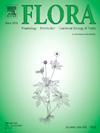Effects of warming and phosphorus on the stoichiometry of native and invasive plant and their rhizosphere soil
IF 1.8
4区 生物学
Q3 ECOLOGY
引用次数: 0
Abstract
Many studies have examined the interactions among multiple global change factors, but their combined effects on plant and soil stoichiometry, particularly in invasive and native plants, remain poorly understood. This study investigated how warming and phosphorus influence plant biomass, and carbon, nitrogen, and phosphorus of a native and an invasive plant species and their soils, and how stoichiometry mediates biomass responses to environmental change. Artemisia argyi (native) and Solidago canadensis (invasive) were treated with warming (2 °C above ambient temperature), phosphorus (4 g m−2 yr−1, NaH₂PO₄), and their combination under single planting. Warming significantly inhibited the total biomass accumulation of S. canadensis (-69.7 %) and A. argyi (-49.0 %). The C:P and N:P of A. argyi significantly increased under warming due to decreased total phosphorus. Structural equation modeling (SEM) indicated that the effect of warming on total biomass accumulation of A. argyi resulted from its direct negative influence. Conversely, phosphorus input increased the total biomass of S. canadensis (+22.8 %) and A. argyi (+11.6 %). SEM showed that phosphorus could promote the total biomass accumulation of S. canadensis directly or indirectly through soil C:N:P. The warming * phosphorus treatment significantly inhibited total biomass accumulation of S. canadensis (-56.4 %) and A. argyi (-50.3 %). Both species exhibited higher N:P under combined environmental treatment, driven by reduced total phosphorus concentration in A. argyi (-24.2 %) and increased total nitrogen concentration in S. canadensis (+70.3 %). Compared with A. argyi, the total biomass of S. canadensis was higher under warming * phosphorus treatment, though its growth stimulation by phosphorus input was significantly inhibited by high temperature. This indicates that rising environment temperature may gradually weaken the growth advantage of invasive plants. In addition, the coupling relationship between plant and soil stoichiometry jointly regulates plant responses to global change, emphasizing the importance of stoichiometry in plant–soil systems.
增温和磷对本地和入侵植物及其根际土壤化学计量的影响
许多研究已经研究了多个全球变化因子之间的相互作用,但它们对植物和土壤化学计量的综合影响,特别是对入侵和本地植物的影响,仍然知之甚少。本研究探讨了增温和磷对原生和入侵植物及其土壤的生物量、碳、氮、磷的影响,以及化学计量学如何调节生物量对环境变化的响应。以艾蒿(Artemisia argyi)和加拿大一枝黄花(Solidago canadensis)为试验材料,采用升温(高于环境温度2°C)、磷(4 g m−2 yr−1,NaH₂PO₄)及其组合进行单次种植。增温显著抑制了加拿大蒿(- 69.7%)和艾叶(- 49.0%)的总生物量积累。增温条件下,由于全磷降低,艾叶的C:P和N:P显著升高。结构方程模型(SEM)表明,增温对艾叶总生物量积累的影响是由增温对艾叶总生物量积累的直接负面影响引起的。相反,磷的输入增加了加拿大蒿(+ 22.8%)和艾叶(+ 11.6%)的总生物量。SEM结果表明,磷通过土壤C:N:P直接或间接促进加拿大蒺藜总生物量积累。增温*磷处理显著抑制了加拿大蒿(- 56.4%)和艾叶(- 50.3%)的总生物量积累。综合环境处理下,两种植物均表现出较高的N:P,这主要是由于艾叶总磷浓度降低(- 24.2%),加拿大蒿总氮浓度升高(+ 70.3%)。与argyi相比,增温*磷处理下加拿大S. canadensis的总生物量更高,但磷输入对其生长的刺激被高温显著抑制。这表明环境温度的升高可能会逐渐削弱入侵植物的生长优势。此外,植物与土壤化学计量的耦合关系共同调节了植物对全球变化的响应,强调了化学计量在植物-土壤系统中的重要性。
本文章由计算机程序翻译,如有差异,请以英文原文为准。
求助全文
约1分钟内获得全文
求助全文
来源期刊

Flora
生物-植物科学
CiteScore
3.30
自引率
10.50%
发文量
130
审稿时长
54 days
期刊介绍:
FLORA publishes original contributions and review articles on plant structure (morphology and anatomy), plant distribution (incl. phylogeography) and plant functional ecology (ecophysiology, population ecology and population genetics, organismic interactions, community ecology, ecosystem ecology). Manuscripts (both original and review articles) on a single topic can be compiled in Special Issues, for which suggestions are welcome.
FLORA, the scientific botanical journal with the longest uninterrupted publication sequence (since 1818), considers manuscripts in the above areas which appeal a broad scientific and international readership. Manuscripts focused on floristics and vegetation science will only be considered if they exceed the pure descriptive approach and have relevance for interpreting plant morphology, distribution or ecology. Manuscripts whose content is restricted to purely systematic and nomenclature matters, to geobotanical aspects of only local interest, to pure applications in agri-, horti- or silviculture and pharmacology, and experimental studies dealing exclusively with investigations at the cellular and subcellular level will not be accepted. Manuscripts dealing with comparative and evolutionary aspects of morphology, anatomy and development are welcome.
 求助内容:
求助内容: 应助结果提醒方式:
应助结果提醒方式:


